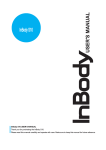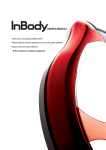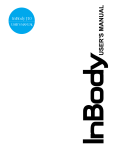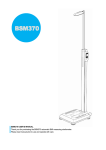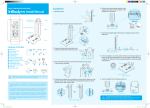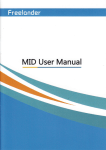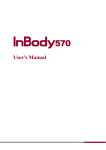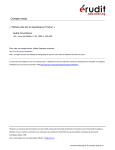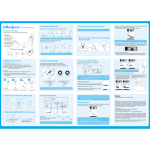Download InBody170 USER`S MANUAL Thank you for purchasing the
Transcript
InBody170 USER’S MANUAL Thank you for purchasing the InBody170. Please read manual prior to use and operate with care. Make sure to keep this manual for future reference. ⓒ 1996-2011 Biospace Co., Ltd. All rights reserved. Notice This user’s manual cannot be copied, translated or transformed into different media without a prior written consent from Biospace Co., Ltd, according to the copyright laws. This user’s manual and product pertinent to this manual may have misprints or technical flaws, which can be modified without prior notice to the readers. Biospace is not liable for any damage caused by a failure to meet the requirements in this user’s manual. Biospace Co., Ltd. [Head office] 518-10 Dogok 2- dong, Gangnam-gu, Seoul 135-854 KOREA TEL : 82-2-501-3939 FAX : 82-2-501-3978 Homepage : http://www.inbody.com E-mail : info @ inbody.com Acknowledgements Biospace, InBody, Lookin’ Body are the registered trademarks of Biospace Co., Ltd. The names of the companies and products in this manual other than those of Biospace Co., Ltd. are the trademarks of the companies. Stating the products of other companies is strictly for the purpose of providing information, and not to guarantee or recommend the products. Biospace is not responsible for the performance or the use of those products. Biospace reserves the right to modify the dimensions or exterior of the InBody170 to improve the quality of the product, without consent of the customer. BM-ENG1-C0-B-111030 Introducing the InBody170 - BODY COMPOSITION ANALYZER Body Composition consists of 4 major components: Water, Protein, Minerals and Fat. These four elements are the fundamental ingredients the body is comprised of, and it is important for them to be in balance. Body composition analysis is expected to quantify and measure these ingredients. Until recently, diagnosing obesity has focused on appearance, without considering a balanced body composition. For more reasonable health care, accurate body composition analysis must be performed first, to achieve the balance of the four major body components. Biospace has earned recognition in the international market for technical expertise demonstrated through the InBody series. Based on the experience and technology over the last 10 years, Biospace has released the body composition analyzer, the InBody170 . With direct segmental measurement, the InBody170 guarantees high accuracy and reproducibility. The InBody170 yields accurate results unique to the individual, regardless of empirical estimations and reliably evaluates the effectiveness of diet control and exercise prescription. Biospace is committed to providing advanced equipment to promote good health and a long life. Kichul Cha, CEO Contents How to use this manual Ⅱ Safety Information Ⅲ Indicators & Safety Symbols Ⅶ Workplace Requirements Ⅷ Chapter 1 Installation & Maintenance Chapter 4 Problems & Solutions 1. Contents of the Box 1 1. Error Messages 48 2. Exterior & Functions 3 2. Troubleshooting 49 3. Installation Instructions 11 3. Frequently Asked Question (FAQs) 51 4. Transportation 21 5. Repacking 22 Chapter 5 Consumables 6. Maintenance 24 1. Consumables 55 Chapter 2 Management & Results Description Appendix 1. Cautions before Measurement 25 1. More about the InBody170 56 2. Power Connection & Getting Started 26 2. Specifications 59 3. Home Screen 28 3. Customer Service Information 60 4. Personal Profile 29 5. Proper Posture 30 6. How to Measure 31 7. Results 34 Chapter 3 Setup Establishment 1. Setup 43 2. Setup Menu 45 How to use this manual This user’s manual explains the functions of the InBody170. Follow the instructions below for effective use. 1. Please read this manual thoroughly prior to InBody170 operation. 2. Take a few moments to review the manual of this product in order to understand configuration. 3. If you have clinical issues while using the InBody170, please contact Biospace customer service. E-mail : info@inbody.com TEL: 82-2-501-3939 4. Read symbols carefully. The following are representations of these symbols. Important information to warn of situations which might cause major injury and/or damage to property if instructions are not carefully followed. Important information to warn of situations which might cause minor injury and/or damage to property if instructions are not carefully followed. Important and helpful information for operation. II Safety Information 1. Do not use this equipment in combination with the following electronic medical devices. - Medical devices, such as a pacemaker - Electronic life support systems, such as an artificial heart/lung - Portable electronic medical devices, such as an electrocardiograph. 2. This product should always be placed on the ground and plugged into a secure electrical outlet. 3. Physically disabled persons or children should receive assistance when measuring on the InBody170 in order to obtain accurate results and avoid injury. 4. Do not insert and remove the power cord with wet hands. 5. Do not jump or apply severe shock to the foot plate, this may cause incorrect measurement or malfunction 6. To prevent damage, please use a socket connected to appropriate power supply(100240VAC). If the socket has several terminals, a socket or extension cable with enough electric capacity should be used. 7. To avoid electric shock, be sure to avoid contact between this product and other devices. 8. Use caution when raising or folding the stand of the equipment to avoid injury. When the stand is raised, do not touch the joint or any other moving part of the stand. Moving parts may cause injury if care is not applied. III 9. Do not dismantle the equipment or open the back cover. Internal parts are not for customer use. If the equipment is dismantled, the warranty is void, and service costs will be charged. If service is required, contact Biospace or the supplying agency. 10. Follow local governing ordinances and recycling plans regarding the disposal or recycling of device components. 11. This device should not be used on pregnant women. Besides providing readings that may be inaccurate, the effect on the fetus is unknown. 1. Cross Contamination Individuals with any kind of contagious disease or infection must not use or come in contact with the foot plate or this product. Please be sure to clean the foot plate with appropriate disinfectant after each use. Never pour any liquid directly on the foot plate, as it may cause internal damage. Use a soft cloth and appropriate ethyl alcohol to wipe off the foot plate. Do not wipe the foot plate with strong chemicals. 2. Test result interpretation and prescription Do not start weight control or exercise therapy without physician’s prescription or expert’s advice. Misguided self-diagnosis may harm your health. If you are pregnant, please consult with undertaking physician or expert before use. 3. Other equipment Please block electromagnetic interferences from other equipments. It may lead to inaccurate test result or error. IV 4. This product must be installed on a flat and stable floor. If the floor is not level, may cause harm or incorrect measurement. 5. Make sure you use the AC adapter provided by Biospace. Using other AC adapter may cause the malfunction of product. 6. Be careful not to spill or drop any residue(food or beverage) on this product. It may cause serious damage to the electronic components. 7. Do not move during measurement for accurate test result. 8. The arm consists of a hand electrode. Do not force the arm in the wrong direction. The resulting damage may affect the functioning of the internal cable and circuit board. 9. Be careful not to hurt your fingers on the edge of the foot plate when handling the screws. 1. Wrong installation contrary to manual guidelines, or other equipment interference, may cause error or inaccurate test results. To solve the interference problem, you should -Separate power supply from the equipment that is causing interference. -Isolate the equipment. -Use a power supply committed only to device. -Please contact Biospace if the problem continues. V 2. Excessively high or low temperatures, humidity and pressure may affect the equipment operation and may cause error. Please use the equipment within the suggested specification range for equipment’s use. 3. While moving, installing, or using this product, be sure to protect against any physical shock or damage. Always use the packing material and the original shipping box when moving or transporting this product. 4. Use this equipment only for the purpose of body composition analysis. 5. Repair and examination should be conducted only by Biospace’s professional A/S staff. Please contact Biospace if needed. 6. The InBody170 fulfills the Standards of IEC60601-1(EN60601-1), Safety of Electric Medical Equipment. In addition, the InBody170 complies not only with Level A for Noise Immunity, but also with Level A for Noise Emission by the Standard IEC60601-12(EN60601-1-2), Electromagnetic Compatibility Requirements. 7. The InBody170 has been designed, manufactured, and inspected under the full quality assurance system of Biospace. Biospace fulfills the international standardization system, ISO 90001 and ISO 13485. VI Indicators & Safety Symbols Disposal of old Electrical & Electronic Equipment (Application in the European Union and other European countries with separate collection system.) This symbol indicates that this product shall not be treated as household waste. Instead, it shall be handed over to the applicable collection point for the recycling of electrical and electronic equipment. By ensuring this product is disposed of correctly, you will help prevent potential negative consequences for the environment and human health, which could otherwise be caused by inappropriate waste handling of this product. For more detailed information about recycling this product, please refer to local governing ordinances and recycling plans. Follow local government ordinances and recycling instructions regarding disposal or recycling of device components, including batteries. VII Workplace Requirements Operation Environment Temperature range 10 ~ 40 ℃ (50℉ ~ 104℉) Relative humidity 30 ~ 75 % Atmospheric pressure range 70 ~ 106 kPa □ Transport and Storage Environment Temperature range -20 ~ 70 ℃ (-4℉ ~ 158℉) Relative humidity 10 ~ 95 % (No condensation) Atmospheric pressure range 50 ~ 106 kPa □ Adapter Power Input AC 100 ~ 240V, 50/60Hz, 1.2A Power Output DC 12V, 3.4A VIII Chapter1. Installation & Maintenance 1. Contents of the box 2. Exterior & Functions 3. Installation Instructions 4. Transportation 5. Repacking 6. Maintenance 0 1. Contents of the box When opening the box, make sure all of the following items are inside. ① InBody170 ② Joint Screw 1EA ③ Joint Cover ④ Thermal Printer ⑤ Screws 4EA ⑥ Thermal Printer Paper ⑦ Thermal Printer Cable ⑧ Adapter 1EA (12V, 3.4A) ⑨ Power Cord 1EA ⑩ Install Manual 1EA ⑪ User’s Manual CD 1EA ⑫ Warranty ⑬ Cable Clips 2EA 1 To prevent physical shock, use Biospace’s packing material when shipping or transporting the equipment. Refer to this Chapter, Section 4: “Transportation.” Save the wrapping material after unpacking for the event of relocation. 2 2. Exterior & Functions Individual part identification and functions with schematic sketches are provided below. Please inspect each component of the InBody170 for damage prior to installation. A. Operation Part (Head) B. Stand Part C. Base Part D. Rear Part A. Operation Part (Head) B. Stand Part D. Rear Part C. Base Part 3 A. Operation Part (1) LCD This displays the analysis procedure, messages and results. (2) Key Pad (19 buttons) The keypad is divisible into input buttons and function buttons. These are used to input data required for body composition analysis, to set up the operating environment and to print out test results. (3) Speaker A signal sound informs users of status such as process or completion of measurement. B. Stand Part (1) Stand (2) Hand Electrode Holder Place hand electrode here when not in use. (3) Thumb Electrode Activated by making contact with the thumb, thus allowing current to flow through the body during measurement. 4 (4) Palm Electrode Activated by wrapping the palm around the electrode, thus allowing current to flow through the body during measurement. (5) Hand Electrode Cable The hand electrode cable is connected to the circuit that transfers voltage and electric current. Please be careful, applying excessive force on the cable attached to the hand electrode may damage the product. 5 C. Base Part Bubble level indicator Joint Cover Front Sole Electrode Rear Sole Electrode Joint Screw Foot Plate Level Screws (1) Front Sole Electrode Activated by placing the fore-foot directly on the front sole electrode. This allows the current to flow through the body. (2) Rear Sole Electrode Activated by placing the heel of the foot directly on the rear sole electrode. (3) Foot Plate The loadcell, which measures body weight, is underneath the foot plate. (4) Joint Cover Remove joint cover on the foot plate and fold the stand. If the joint cover is not removed before folding the stand, the product can be severely damaged. 6 (5) Joint Screw This is the joint screw which fixes the upper part in such a way it does not move. (6) Bubble Level Indicator Used to level the InBody170 by means of a view glass and bubble alignment. <Unleveled state> <Raise> <Leveled state> <Lower> (7) Level Screws There are 4 leveling screws that support the equipment. Leveling screws are designed to be turned by hand, so you can easily adjust the balance of the equipment. 7 D. Rear Part (1) Back Cover Only qualified personnel are allowed to remove the back cover. Do not dismantle the equipment. Internal parts are not for customer use and may cause electric shock. If the equipment is dismantled, the warranty is void, and service costs will be charged. If you have any problems with device quality or operation, please contact the manufacturer or the distributor. 8 (2) Control & Connection Unit Connect to peripherals such as a PC or a printer for data transmission. ① USB Slave Port Use to connect with a PC. ② 9pin Serial Port, Female (RS-232C) Use to connect optional devices i.e. thermal printer or blood pressure monitor provided by Biospace. ③ Power Input Port Use to connect the power adapter. ④ Power Switch Power the InBody170 on/off. 9 Since the control and connection part is located below the rear part of the equipment, liquid or foreign matter may flow into the equipment. The liquid or foreign matter which has flown into it could cause a critical damage to any electronic parts. Do not touch signal input, signal output or other connectors, and the patient simultaneously. External equipment intended for connection to signal input, signal output or other connectors, shall comply with relevant IEC Standard(e.g., IEC60950 for IT equipment and IEC60601-1 series for medical electrical equipment). In addition, all such combinationsystem-shall comply with the standard IEC60601-1 and/or IEC60601-1-1 harmonized national standard or the combination. If, in doubt, contact qualified technician or your local representative. Use the adapter provided by Biospace only. When using the adapter cable, insert the adapter cable tightly into the InBody170. Including the optional equipment, only the peripherals provided by Biospace can be connected to the InBody170. For any inquiry about peripherals, contact Biospace. 10 3. Installation Instructions A. Workplace requirements (1) Location: Indoor only. Any outdoor area where the equipment is to be located should meet all the conditions below. (2) Operation environment: 10 ~ 40℃(50 ~ 104 °F), 30 ~ 75%RH, 70 ~ 106kPa (3) Adapter: Power Input 100-240V, 50-60Hz, 1.2A Power Output DC 12V, 3.4A B. Note on Unpacking & Assembling Be sure to read these instructions carefully before assembling. (1) Place the equipment on level ground. (2) Don’t move by holding the control part with LCD. (3) Move the equipment referring to the following picture. Mount the hand electrode on the packing pad. 11 C. Unpacking & Installation (1) Unpack the box and remove the top pad. Please keep the packaging for future events of repacking InBody170 and sending it for servicing or otherwise transporting InBody170 elsewhere. (2) Place the equipment horizontal to the ground. (3) Raise the stand of the equipment carefully until it stands upright. Use caution when raising the stand body of the equipment to avoid injury. When the body stand is raised, do not touch the joint part by hand or with any other part of the body. There is a danger of such hand or part of the body getting jammed in between the joints. 12 (4) Tighten the joint screw connecting stand body and foot plate. After upper part of the InBody170 is fixed, close the joint cover. (5) Connect the thermal printer firmly to the supporting metal plate using the screws. 13 (6) Open the thermal printer lid and insert the thermal printer paper in the direction illustrated. Use the printer paper provided by Biospace only. (7) Thermal printer cables are connected as shown below. Attach the cable clips to the back of the InBody170 as illustrated below and fix the thermal printer cable into the cable clips. 14 (8) Connect the thermal printer cable and the adapter to the ports on the rear panel of the equipment as illustrated. <Rear view of InBody170> (9) Connect the adapter to the power cord and plug it to the wall outlet. <Side view of InBody170> 15 (10) If the air bubble is not in the center of the level indicator, tighten or loosen the leveling screws (4EA) on the foot plate to adjust the level of InBody170. InBody170 must be leveled properly for accurate weight measurement. <Leveled State> < Raise > < Lower > Use caution when handling screws to avoid injury. 16 (11) Turn the InBody170 and thermal printer on. <Rear view of InBody170> Power Switch Do not touch the base when turning on and during warm up. Applying pressure or weight to the base during warm up will result in an inaccurate calibration, which may cause the measurements to be inaccurate. 17 D. Set up connections with optional devices (1) When you use an optional device only A. Necessary cable ① RS-232C cable B. Connection <Connect the RS-232C cable to the optional device> 18 (2) When you use thermal printer and an optional device A. Necessary cable ① Y-type cable ② Thermal printer cable ③ RS-232C cable B. Connection 19 (3) When you use thermal printer and optional devices A. Necessary cable ① Y-type cable ② Thermal printer cable ③ SD400 cable ④ RS-232C cable B. Connection Y-type Cable 20 4. Transportation If it must be transported, be extra careful to ensure safe handling. The following are some tips for safely transporting the InBody170: (1) Before transporting the InBody170, turn off the power switch and unplug the adapter. (2) Be careful not to damage the hand module. (3) After moving the InBody170, ensure that it is placed horizontal to the ground. A. Environmental Requirements Storage environment: -20 ~ 70℃ (-4℉ ~ 158℉), 10 ~ 95%RH 50 ~ 106kPa (No condensation) B. Transporting Before Installation Before installation, the InBody170 is shipped in the box designed by Biospace. For safety, have two people move it by holding both sides or use handling equipment such as a cart or dolly. Be careful with fragile freight. The package has fragile operation parts including LCD, which has the sign on the box. After relocating the InBody170, make sure it is level again. Inaccurate leveling will affect accuracy of individual weight measurements. 21 5. Repacking Be sure to turn off the power switch and unplug the power cable before repacking. Be careful to avoid severe physical shock, jarring or other damage while repacking, especially with regard to the arm and foot electrodes. (1) Turn off the power switch. (2) If a thermal printer is attached to the InBody170, remove the thermal printer first. Remove all cables connected to the InBody170. (3) Open the joint cover. Loosen the screw on the foot plate. (4) Slowly fold the stand of the InBody170 carefully. 22 Use caution when handling screws to avoid injury. Do not touch the joint part by hand or with any other part of the body. There is a danger of such hand or part of the body getting jammed in between the joints. (5) Hold the hand electrode cable and make sure that it is not twisted. (6) Insert the hand electrode cable into the hole on the packing pad. (7) Mount the hand electrode on the packing pad. Mount the other hand electrode in the same way. (9) Put the equipment in the box. (10) Seal the box with a tape. 23 6. Maintenance (1) After usage, wipe electrodes with a wet tissue(also known as wet naps, surface wipes, anti-bacterial tissues, etc.). Wet tissues can be purchased at any local store. (2) Handle the arms with care. Never apply excessive force near the hand electrode joint. The damage caused by misuse may affect the function of the internal cable and electric board. (3) Do not place anything on the foot plate or apply any pressure onto it when the InBody170 is not in use. (4) When the InBody170 is not in use for a period longer than one day, unplug the adapter. (5) Do not move or relocate the InBody170 while the power is on. (6) Do not drop any food or liquid on the equipment. It may affect the electrical parts in the equipment or cause damage. (7) Once a week, wipe the exterior sides of the InBody170 with a dry towel. In particular, clean the LCD monitor, using gentle care not to scratch the surface. (8) Follow local governing ordinances and recycling plans regarding the disposal or recycling of device components. 24 Chapter 2. Management & Results Description 1. Cautions before Measurement 2. Exterior and Function of Keypad 3. Home Screen 4. Personal Profile 5. Proper Posture 6. How to Measure 7. Results 25 1. Cautions before Measurement To observe changes of the human body through body composition analysis, it is crucial to perform the analysis each time under the same conditions, temperature, posture, etc. Bear in mind, the following factors affect the results of body composition analysis, and as a result, affect the reproducibility of analysis. (1) Make sure not to use this equipment with those that have medical electrical devices, such as a pacemaker. (2) Do not eat before measurement. (3) Do not exercise or perform any physical activities before testing. If an examinee has already been physically active, a temporary change in body composition will result. (4) Do not take a bath or shower prior to measurement. (5) Perform the measurement after urination or excretion, if possible. Residues inside the human body are interpreted as fat mass. Waste in the body means the analysis will be less accurate. (6) Measurement should ideally be done before mid-day. (7) Perform the measurement under normal temperature conditions 20~25°C (68~77 °F). If the ambient temperature is too high or too low, the human body responds, resulting in temporary changes in body composition. 25 2. Exterior and Function of Keypad Keypad is located below the LCD Monitor. The InBody170 has a keypad for data input. To input all information, press the relevant buttons on the keypad. ① Numerical Buttons (0~9) The input buttons are use to enter alpha-numeric data such as the examinee’s age, height and ID. With each button press, number is displayed in the sequence shown on the keypad. ② Directional buttons The directional buttons consist of left and right. ③ Setup button Use the SETUP button when setting up the InBody 170 ④ EXIT button EXIT button is use to stop the process that is in progress or go back to the previous process. ⑤ Print button Use the PRINT button to print the results of the last person who did the test. 26 ⑥ SOUND button Use to control sound volume. ⑦ Male, Female button It is used for gender input when entering personal information. ⑧ ENTER button This button is used when data input is finished or to move on to the next item. ⑨ Zero Setting button(0 button) If 0 point of weight is not correct, press ‘0’ button and hold button until you hear a beep sound. ⑩ ID button (Left directional button) To input ID, move the cursor to the left of the gender section with the ID button. 27 3. Home Screen (1) Connect the InBody170 power adapter behind the foot plate. (2) When system switch is turned on, the screen is displayed as illustrated below. 28 4. Personal Profile Height and weight are essential information for body composition analysis, and for more comprehension, age and gender are used to provide normal range. The InBody170 analyzes the measurement results based on the input data. To reduce errors and acquire more reliable results, input examinee’s data after reading the following. (1) Weight (permitted range: 10kg ~ 250kg / 22 lb. ~ 551 lb.) The measured weight is automatically added to the weight column. When the unit is changed, the weight will change automatically. It is also possible to adjust the weight to account for clothing weight and accessories. (2) Gender You can select the gender by using the Male or Female buttons. (3) Age (Recommended input range: 3 ~ 99 years) Use the keypad to enter age. (4) Height (Recommended input range: 95cm ~ 220cm, 3ft. 1.4in. ~ 7ft. 2.6in.) Use the keypad to enter height. It is possible to select the unit you want to use between inches and cm. 29 5. Proper Posture Proper posture is essential to achieve reliable results and high reproducibility. Do not talk or move during the InBody Test. 30 6. How to Measure The following procedure is based on the initial setting of the InBody170. (1) Confirm the InBody170 is ready for measurement. If it is ready, the following screen is displayed. (2) Remove heavy clothes and accessories before stepping on the InBody170. (3) Stand on the foot plate of the InBody170 and do not move until the weight is displayed. 31 (4) Once weight measurement is complete, the result will be displayed as illustrated below. To enter your ID, please press button. Use setting for the user’s preference with stage to input ID. Refer to Chapter 3, Section 2: “Setup Menu” (5) Use the input buttons to enter gender, age and height in order. You must press the button after entering each item in order to proceed. Please enter your gender, age and height accuately. 32 (6) Maintain correct posture and the measurement will begin. When the measurement is complete, the results screen will be displayed as illustrated below. (7) Once the measurement is complete, step off the foot plate. The thermal printer will automatically print the results sheet about 15 seconds later. 33 7. Results A. Result Screen During measurement, the InBody170 displays information of an examinee’s body composition on the LCD. The results are shown on the LCD while an examinee is standing on the equipment. Through the display of the results, you can check the main items of the results. (1) Weight (2) Skeletal Muscle (3) Percentage of Body Fat (4) Visceral Fat 34 B. Results Sheet If the thermal printer is connected, you can print the results sheet. Only the thermal printer provided by Biospace can be used with the InBody170. 35 C. Output Items The following are the definitions and explanation for each item analyzed on the results sheet. The normal range on the result sheet is the standard provided by Biospace based on the Biospace possessed reference data. Basically, the result sheet shows measured values for each test item. Regarding the standard result as 100%, it shows the ratio of measured values to standard values with the bar graph’s length. The normal range will be set according to the standard value to enhance examinee’s easy understanding of result sheet. (1) Personal Information The examinee’s ID, gender, age, height, weight, exam date and time are displayed here. (2) Body Composition Bar graphs and values for Weight, Muscle Mass (Skeletal Muscle) and Body Fat Mass are displayed here. The length of bar graph shows a percentage relative to the standard value (100%) and the value at the end of each bar is the measured value. The standard value (100%) is based on the standard weight of the examinee. When an examinee is on a diet or exercising for weight control, body fat mass and skeletal muscle mass get affected among the body compartments. Therefore, you can keep monitoring the changes of body fat mass and skeletal muscle mass performing a weight control program. Also, you can see the body composition goes along your expect. 36 ⓛ Weight (kg or lbs.) Standard weight is based on examinee’s height. The normal range of weight is 85~115% based on the normal range of BMI. Using the classical BMI method, the InBody170 identifies the standard BMI as 22kg/m2 for males, 21.5kg/m2 for western females and 21kg/m2 for asian females. Formula to get standard weight Male Female 2 Standard Weight = Height (㎡) × 22 2 (asian) 2 (western) Standard Weight = Height (㎡) × 21 Standard Weight = Height (㎡) × 21.5 ② Muscle (Skeletal Muscle Mass, kg or lbs.) Distinctively, skeletal muscle mass, which generally indicates the lean body mass of each arm and leg, can be controlled by exercise and dietary habits. Compare the bar graphs’ lengths of skeletal muscle mass with body fat mass. If the bar of skeletal muscle mass is relatively shorter and under the standard value, lean body mass lacks in the body, while the opposite case is proper. 100% signifies ideal lean body mass when examinee’s weight is normal. The normal range is 90~110% of standard skeletal muscle mass based on standard weight. ③ Fat (Body Fat Mass, kg or lbs.) 100% signifies ideal body fat mass when examinee has standard weight and standard percent body fat. The normal range is 80~160% of ideal percent body fat. *The normal range varies for the each item because the variation rates of muscle and fat are not same in normal condition. 37 ④ TBW (Total Body Water, ℓ or lbs.) The total volume of water in the body. It is shown as “ℓ” on the results sheet. However, mass measured in kilograms (kg) is the basic unit of measure for body composition components. Therefore, the unit volume of water should be converted to a mass unit. It is a common known fact that the volume of 1 liter (ℓ) is equal to the mass of 1kg in water. This fact allows volume and mass to be interchangeable i.e. used at the same time. ⑤ FFM (Fat Free Mass) (kg or lbs.) Fat Free Mass refers to the components of body weight with the exception of body fat mass. (3) Obesity Diagnosis This enables examinee’s to check BMI, the classical method for obesity diagnosis, percentage of body fat, waist-hip ratio and visceral fat (level) all at once. ⓛ BMI (Body Mass Index, kg/㎡) BMI is determined by using only weight and height and diagnoses superficial obesity. The standard values are 22kg/m2 for male and 21.5kg/m2 for western female and 21kg/m2 for asian female. Formula) 2 BMI = weight (kg) ÷ height (㎡) 38 Determination 1) WHO Standard BMI(kg/㎡) Classification Diagnosis <18.5 Underweight Under Infectious disease, malnutrition related disease 18.5~24.9 Normal Standard Least risk at most disease 25.0~29.9 Overweight 30.0~34.9 Obese1 35.0~39.9 Obese2 >40 Severely Obese May cause health problem Over Increase of the risk of cardiac disease, high blood pressure, diabetes, etc Ref. WHO and the National Heart, Lung, and Blood Institute: clinical guidelines on the identification, evaluation, and treatment of overweight and obesity in adults, the evidence report. June 1998, xiv Determination 2) Asian-Pacific Standard BMI(kg/㎡) Classification Diagnosis <18.5 Underweight Low (high risk of other clinical disease) 18.5~22.9 Normal Average >23 Overweight 23~24.9 Risky Overweight Increased 25.0~29.9 Obese step1 Moderate >30 Obese step2 Severe Ref. Korean Society for the Study of Obesity, chapter 2. Redefining and Evaluation, The Asian-Pacific perspective : Redefining Obesity and its Treatment:, 1st edition, Korean Society for the Study of Obesity, 2001, p10. *For children under the age of 18, children’s standard is used. ② PBF (Percentage of Body Fat, %) Percentage of Body Fat indicates the percentage of body fat to body weight. The ideal percentage of body fat is 15% for men and 23% for women, while the normal range of Body Fat Mass for men is 10-20% of the weight and 18-28% of the weight for women. In the case of children under the age of 18, children’s standard is used. Ref. Samuel J. Fomon, et al. (1982): Body Composition of reference children from birth to age 10 years. The American Journal of Clinical Nutrition 35, 1169-1175. 39 ③ WHR (Waist-Hip Ratio) Waist-Hip Ratio (WHR) means ratio of waist and hip circumference. The InBody170 yields WHR value saving the effort of tape measurement, using the principle which figures out body size with segmental bioimpedance and reference of empirical factors. The normal ranges are 0.80~0.90 for male and 0.75~0.85 for female. Abdominal obesity is diagnosed in case of over 0.95 for male and 0.90 for female. Ref. 1. Judith E. Brown, Nutrition Now, 2nd edition, pp9-8, published by West/Wadsworth, 1999. 2. NIH, Bioelectrical impedance analysis in body composition measurement : National Institute of Health, 1996. Technology Assessment Conference Statement, 524S-532S, December 12-14, 1994. ④ Visceral Fat (Visceral Fat Level, level) Visceral fat level refers to the visceral fat area. Body fat is divided into categories depending on the location of the fat: visceral fat, subcutaneous fat, and the fat between your muscles. An individual with a visceral fat area of more than 100cm2 is considered to be abdominally obese in the visceral fat area. So an individual with a visceral fat level of more than 10 level is considered to be abdominally obese in the visceral fat. * Generally, even though infants have a high WHR (Waist Hip Ratio), they have low visceral fat than adults. The reason is because infants have mostly subcutaneous fat. The older we are, the visceral fat area might increase even if WHR remains the same. ⑤ BMR (Basal Metabolic Rate, kcal) Basal Metabolic Rate is the minimal energy required to maintain life and homeostasis i.e. energy for breathing, heart activity, body temperature regulation and so on. The InBody170 calculates BMR as referring to Fat Free Mass (FFM) mentioned in the reference below. Ref. John J Cunningham. Body composition as a determinant of energy expenditure : a synthetic review and proposed general prediction equation. Am J Clin Nutr. Vol.54, 963-969, 1991. *In general, Harris-Benedict Equation is used for BMR. This equation concerns gender, age, height and weight. However, calculating BMR with Fat Free Mass, which is the most active mass in a body, brings out more analogous results closed to the directly measured BMR. Also, respiratory gas analyzer can compute relatively accurate BMR. 40 (4) Segmental Lean ‘Segmental Lean’ shows segmental lean mass and its overall evaluation. (5) Segmental Fat ‘Segmental Fat’ shows segmental fat mass, percentage of body fat and its overall evaluation. (6) Muscle - Fat Control Muscle- Fat control suggests fat and muscle (Fat Free Mass) control that leads to the balanced body composition to achieve ideal body composition. The (+) and (-) signs indicate an increase or decrease in the amount of control. ⓛ Muscle Control (kg or lbs.) The amount of muscle to be controlled for optimum muscle mass based on the results of body composition analysis. ② Fat Control (kg or lbs.) The amount of fat to be controlled for optimum body fat mass based on the results of body composition analysis. 41 *If fat mass is over the standard, it is suggested to lose fat. However, no suggestion for muscle loss is offered in the case of muscle excess. Although muscle is often lost during weight control, there is no document supporting intended muscle loss. Therefore, the InBody170 proposes 0.0kg for muscle control, which means no muscle control needed’, when an examinee is overweight for excessive muscle mass. (7) Fitness Score The Fitness Score is offered in numeric value to help people remember the status of their body composition easily. This is the peculiar index of Biospace without any document or reference. Setting 80 as standard, less than 70 means ‘weakness’, from 70 to 90 means ‘normal’, greater than 90 means ‘athletic type’. (8) Body Composition History Body Composition History offers up to 10 monitoring data in table enabling to see examinee’s recent body composition change at a glance. The table shows 3 major Body composition items such as weight, skeletal muscle mass and body fat mass of each measurement date and time. (9) Impedance The InBody170 provides impedance of each segment at multiple frequencies. The impedance value must decrease in the arrow direction. 42 Chapter3. Setup Establishment 1. Setup 2. Setup Menu 3. DATABASE 43 1. Setup The InBody170 has a function to modify the setting for the user’s preference. A. Enter the SETUP menu (1) You can see the below screen, by pressing SETUP button. (2) Press the password and press button. You can see the below screen. The default password is “0000”. This function is to prevent unauthorized examinee use of modifying the setting. 43 B. How to modify Setup • Press the • Press the • button to save the settings. button to exit without saving changes. buttons are for navigating between items. • When there is no input for 1 minute, the setup screen will be closed automatically. • The item with flashing cursor is the currently set item. 44 2. SETUP Menu (1) Weight Adjustment Value Setting Use the number buttons to set weight adjustment value. This value will be subtracted from the actual weight measurement. (Offset Range: 0.0lbs. ~ 9.9lbs., step: 0.1lbs. / 0.0kg ~ 5.0kg, step: 0.1kg) (2) ID Input Setting Use the 1 or 2 button to set the ID input mode. Select 1 for entering ID before taking measurement, or select 2 to skip entering ID before taking measurement. ① 1 : It is require a stage to input ID. ② 2 : It does not require a stage to input ID. (3) Unit Setting Use the 1 or 2 button to set the desired unit. Select 1 for kg-cm, or select 2 for lbs.-in. (4) External Peripherals Connection Setting Use the 1, 2, 3 buttons to select an external peripherals connection method. Select 1 to connect one peripheral at a time, select 2 to connect another peripheral while using a thermal printer, or select 3 to connect SD400 while using a thermal printer. ① 1 (dc) : Select when you use an optional equipment only. (e.g.Thermal printer, Stadiometer , Blood pressure monitor) 45 ② 2 (yc) : Select when you use another optional equipment while using a thermal printer ③ 3 (Sd) : Select when you use SD400 while using a thermal printer. You can connect other optional equipments using SD400. (5) Ethnic Background Use the 1,2,3,4 buttons to select the ethnic background of the examinee. Select 1 for Asian, 2 for Caucasian, 3 for African and 4 for Hispanic. (6) BMI Standard Setting Use the 1 or 2 button to set BMI standard. Select 1 for “Asian standard”, 2 for “WHO standard”, and 3 for “Chinese standard”. ① 1 : Asian standard. The normal range is 18.5~23kg/㎡. ② 2: WHO(World Health Organization) standard. The normal range is 18.5~25.0kg/㎡. ③ 3: Chinese standard. The normal range is 18.5~24.0kg/㎡. (7) Fitness Score Setting Use the 1 or 2 button to set printing “Fitness Score” on results paper. Select 1 for printing “Fitness Score”, or select 2 to skip printing “Fitness Score”. 46 (8) Password Setting Specify password required to enter the setup. Enter setup password and press the button. Enter the new password again and press the button to finish saving the new password. (9) Date/Time Setting Use the direction buttons(◀, ▶) or numerical buttons to set for date/time. * Date Display Mode Setting If you press button in Date/Time setting menu, you can also select the date display mode. Use the direction buttons(◀, ▶) to select display mode (YY/MM/DD, MM/DD/YY, DD/MM/YY) and press the button to save the setting and go back to the ‘Date/Time Setting’ menu. 47 Chapter4. Problems & Solutions 1. Error Messages 2. Troubleshooting 3. Frequently Asked Question (FAQs) 48 1. Error Messages The InBody170 may display the following error messages to alert the operator of problems and to recommend the correct action. A. Cause 1 Fundamental problem of the device suspected. Actuion1 Please contact Customer Support. (info@inbody.com) 48 2. Troubleshooting This section lists the order of steps you should take in case of malfunction, with the assumption that you have some basic knowledge about how to operate the equipment. If you still have the problem after taking the following steps, contact Biospace. A. InBody170 does not seem to run, even after the power is on. (In a normal situation, a signal sounds and the LCD is turned on.) Cause 1 The plug is not pushed all the way into the electrical outlet. Actuion1 Push the plug all the way into the electrical outlet. Cause 2 Extension is not turned on (when using a surge protector) or the power does not flow into extension. Action 2 Check if the power flows into the extension and the electrical outlet where the extension is connected. Cause 3 When an adapter not provided by Biospace is used. Action 3 Use the adapter provided by Biospace only. Cause 4 Adapter is not tightly inserted into the InBody170. Action 4 Insert the adapter into the power input port tightly. B. The measured weight value seems very low, or shows a negative value. (Normally the measured weight is not very different from what the examinee believes his or her actual weight to be.) Cause 1 The weight sensor (load cell) calibration was performed wrong during the selfcalibration. Action 1 Turn off the power of the InBody170, then turn it on again. Allow the unit to 49 perform the self-calibration process again with no weight on the foot plate. The load cell will be set to 0 kg during self-calibration. Keep in mind, even a small amount of weight affects the calibration negatively. C. The analysis results are unexpected or unusual. (It is not common to observe unexpected values. All analyzed values should not be outside of pre-determined ranges.) Cause 1 An examinee failed to maintain proper posture. He or She removed fingers or the sole of the foot from the tactile points of the electrodes. Action 1 He or She must maintain proper posture until the analysis is complete. Refer to Chapter 2, Section 6: “Proper Posture,” for more information. If the repeated analysis results are the same, contact Biospace. 50 3. Frequently Asked Question (FAQs) Even if no problems arise from the equipment, users may still have many questions especially regarding clinical procedures. Below are a few of the more common questions with answers. If additional questions or more clarification is desired, please contact us by Email. The E-mail address for clinical questions is as follows: E-mail: info@ biospace.co.kr Q1. I do not know how to configure the settings. Press the button and then press the button. The setup manual will be printed by the thermal printer. Refer to the manual for descriptions of setup menu items and setup instructions. Q2. I pressed the button in order to change the setup configuration but InBody170 is asking for the access code (or password). What is the access code? The factory default access code is “0000.” and it may be changed in the setup menu. Q3. How do I adjust the sound volume? Press the , button on the home screen to adjust the sound volume. To mute the voice guide, press the button. The icon at the bottom of the home screen will disappear. Q4.I would like to set ID every time I use InBody. Is there an easy way to do this? Press the button. → Enter the access code (default is “0000”). → Press the button twice, you can see the button and then the . → Press the button. → Press button to bring up the home screen. 51 Q5. How do I change Date/Time? Press the button. → Enter the access code (the default is “0000”). → Press the button. → Press the button until you see . Date/time are displayed at the bottom of the screen and they can be changed by using the number buttons. Q6. The thermal printer is not printing results sheet. Ensure that the thermal printer is turned on. Also check that the paper is loaded in the thermal printer and the thermal printer cable is correctly connected. Q7. Where can I buy thermal printer paper and other optional devices? Please contact Biospace or the local distributor. Q8. How do I know the measurement taken is correct? After taking the measurement, check the impedance at the bottom of the results sheet printed. The impedance value must decrease in the arrow direction. 52 Q9. How do I clean the hand/foot electrodes? Please use InBody tissues provided by Biospace and wipe the hand/foot electrodes. InBody tissues have antibacterial functionality which protects cross-contamination. Q10. Do I have to use InBody tissue? Can I just use wet cloth? The InBody tissue that comes with the InBody170 is specially designed for optimal testing, as opposed to other wet cloth. Always use the InBody tissue for accurate testing. Q11. Must socks or stockings be removed from the feet for analysis? Bare skin contact is essential in the analysis using the BIA method. Socks or stockings may cause a certain amount of distortion in the results. Socks and stocking must be removed to obtain accurate data. Q12. What are the circumstances where an analysis cannot be performed? Examinee who has a pacemaker or other internal electronic medical devices should never use the InBody170. Q13. Is the electrical current applied to a human body through electrodes safe? Yes. The BIA method uses an electrical current, but is practically harmless. The InBody170 has acquired the CE and other certifications that assure the safety of the medical equipment. Q14. Do accessories (jewelry, watches, rings, etc.) or any other metal objects worn by an examinee affect the analysis? The ideal condition for the analysis is simply standing with no clothes (naked) and wearing no accessories. However, this may not always be possible. Therefore, we recommend that the examinee removes as many clothing items and accessories that may affect the weight as possible. 53 Q15. How often does the examinee perform the analysis? The body composition changes by inches but continuously according to steady diet, work out, or medical treatment, etc. We recommend you to measure the InBody170 once every two to four weeks to reliably see the changes. Q16. How does the examinee follow for accurate analysis? For accurate analysis, Biospace recommends the following: - Measure with an empty stomach. - Measure 2 hours after a meal or on an empty stomach. - Measure after urination and excretion. - Remove heavy clothes or accessories. - Do not exercise or take a shower before measurement. - Measure after standing for at least 5 minutes. - Do not measure after abruptly standing up. - Do not measure while taking a diuretic. - For females, avoid having measurement during menstrual period as total body water will be higher than normal. - Input accurate height. - Keep room temperature at 20 ~ 25℃ (68 ~ 77℉). - Warm up yourself for 20 minutes before a test performed in winter. 54 Chapter5. Consumables 1. Consumables 54 1. Consumables A. Roll Paper of Thermal Printer 1) Size - Width: 57mm - External diameter: 45mm 2) Number of roll: 1 roll / 1 box 55 Appendix 1. More about the InBody170 2. Specifications 3. Customer Service Information 56 1. More about the InBody170 A. How does BIA work? The Bioelectrical Impedance Analysis (BIA) method is based on the fact that the human body consists of conductors and non-conductors. Generally, 50~70% of the human body consists of water which functions as a conductor, whereas body fat functions as a nonconductor. The classic BIA method measures the impedance of the whole body on the assumption that the human body can be considered a cylinder for the application of this model. If A is the cross sectional area, and L is the length, the impedance of the cylinder can be expressed as follows. If both sides are multiplied by L, We get the new expression as follows. According to this expression, if we know the L and the impedance value, we get the volume. That is to say, if we know the height of the human body (acting as a conductor), and know the impedance value, we can get the volume of body water. Here, the volume represents examinee’ height. Therefore, the two directly used variables in body composition analysis are impedance and height. The principle of the InBody170’s body composition analysis is explained by the following; the volume of body water, an electrolyte, is calculated first with a measured impedance value. Then, we can get the value of fat free mass using the volume of body water. Body fat mass is determined by deducting the lean body mass from the measured weight. Height should be entered by the user. Weight can be directly measured on the InBody170. 57 B. Core Technology The following are key features that make the InBody170 extremely convenient, timely, and accurate. (1) Segmental Analysis There are some claims to be able to estimate the body composition separately; there is no technology which can really measure it separately other than Biospace. Segmental measurement is the technology that assumes the body as five cylinders of four limbs and trunk and measures the impedance of these parts separately. Segmental body composition analysis provides segmental measurement of body water, muscle mass, and fat free mass. Furthermore, the analysis is highly accurate because the measured value of a certain part does not affect the measurements of other segments. It is because body composition analyzers lack accuracy in measuring body fat and cannot figure out the examinee’s exact shape that they must rely on empirical references to correct inaccurate measured values. But, the InBody with the technology of segmental analysis can exactly figure out difference by gender, aging, disease and ethnic without any empirical estimation. Based on the fact that fat free mass (FFM) consists of about 73.3% of body fluid, it can be concluded that the distribution of body fluid reflects the distribution of FFM. Because the InBody can analyze the segmental body fluid distribution (each arm, trunk, and each leg separately), it can as a result examine a examinees segmental development. (2) Tetrapolar 8-Point Tactile Electrode It was a complex and inconvenient procedure to attach and detach the electrodes to a specific spot every time. Trained technicians were needed for each measurement. The 58 InBody170 uses tactile electrodes to avoid the possibility of errors and inaccuracies. The 8point Tactile Electrode method enables the InBody170 to efficiently produce accurate data every time. C. Classifications The product received classifications in the following: Type of protection against electric shock : Class I Type of the applied parts : BF Type Degree of protection against water infiltration : IPXO EMC Immunity : Level A EMC Emission : Level A Equipment is not suitable for use in the presence of flammable mixture. Any changes or modifications in construction of this device which are not expressly approved by the party responsible for compliance could void the user’s authority to operate the equipment. 59 2. Specifications Items & Standard Bioelectrical Impedance(BIA) Measurement Items Electrode Method Measurement Method Body Composition Calculation Method Outputs Applied Rating Current Adapter Display Type External Interface Dimensions Weight Operation Environment Storage Environment Weight Range Age Range Height Range BODY COMPOSITION ANALYZER of Direct Segmental Multifrequency Bioelectrical Impedance Method 10 Impedance measurements by using 2 Bioelectrical different frequencies(20㎑, 100㎑) at each 5 Impedance(Z) segments of the body(Right Arm, Left Arm, Trunk, Right Leg, Left Leg) Tetrapolar 8-Point Tactile Electrodes Direct Segmental Measurement Bioelectrical Impedance Analysis Method; DSM-BIA method No use of Empirical Estimation. Weight, Skeletal Muscle Mass, Body Fat Mass Total Body Water, Fat Free Mass BMI, Percent Body Fat, Waist-Hip Ratio(WHR) Basal Metabolic Rate (BMR), Visceral Fat Level Segmental Analysis of Lean and Fat (Right arm, Left arm, Trunk, Right leg, Left Leg), Muscle Control, Fat Control Fitness Score, Body Composition History Impedance at Each Segment & Frequency 250㎂ Power Input AC100-240V, 50/60Hz, 1.2A Power Output DC 12V, 3.4A EBTN Custom LCD RS-232C 1EA, USB Slave 1EA, 396(W) X 608(L) X 955(H) : mm 15.6(W) X 24(L) X 37.6(H) : inch 14.3kg (31.5 lbs.) Temperature: 10 ~ 40℃(50 ~ 104℉) Humidity: 30 ~ 75%RH Pressure: 70 ~ 106kPa Temperature: -20~ 70℃(-4 ~ 158℉) Humidity: 30 ~ 95%RH Pressure: 50 ~ 106kPa 10 ~ 250kg (22 ~ 551lbs.) 3 ~ 99years 95 ~ 220cm (2ft. 9.5in. ~ 7ft. 2.6in.) * Specifications may change without prior notice. 60 3. Customer Service Information Corporate agents of the InBody170 and addresses are listed below. Contact us for assistance or more information about the InBody170. Biospace Co., Ltd. 518-10, Dogok 2-Dong, Gangnam-gu, Seoul 135-784 KOREA TEL: 82-2-501-3939 FAX: 82-2-501-3978 Website: www.e-inbody.com E-mail: info@inbody.com Biospace Inc. [U.S.A] 4801 Wilshire Blvd. Suite 320 Los Angeles, CA 90010 U.S.A TEL : 1-323-932-6503 FAX : 1-323-932-6506 Homepage : http://www.biospaceamerica.com E-mail : USA@biospaceamerica.com Biospace Japan Inc. [JAPAN] Second Floor Ayabe Bldg., 2-17-3 Sotokanda, Chiyoda-ku, Tokyo JAPAN TEL : 81-03-5298-7667 FAX : 81-03-5298-7668,7669 Homepage : http://www.biospace.co.jp E-mail : biospace@biospace.co.jp DanilSMC Co., Ltd. [Asia] 3th Floor J Bldg., 35-25 Jamwon-dong, Seocho-gu, Seoul 137-905 KOREA TEL : 82-2-3462-5400 FAX : 82-2-3462-5105 E-mail : danilsmc@danilsmc.com EU Representative. [Europe] DongBang Acuprime. Gater House, Gater Lane, Palace Gate, Exeter, EX1 1JL, UK TEL : 44-1392- 273908 FAX : 44-1392- 273909 E-mail : info@acuprime.com Biospace China. [CHINA] Block A, 26/F, Hai Xing plaza, No. 1 South Ruijin Road, Shanghai 200023, CHINA TEL : 86-21-64439738, 9739, 9705 FAX : 86-21-6443906 Homepage : http://www.biospacechina.com E-mail : admin@ biospacechina.com 61














































































